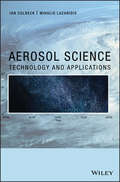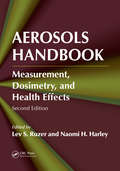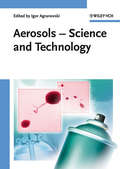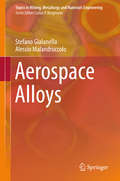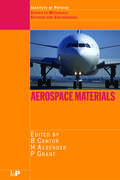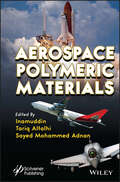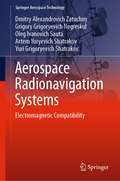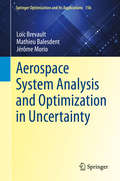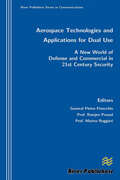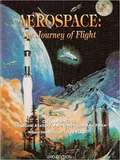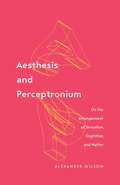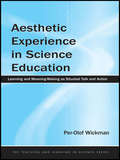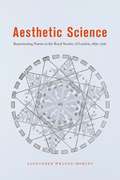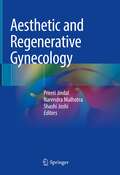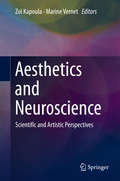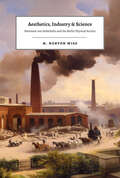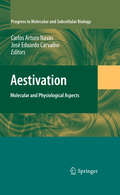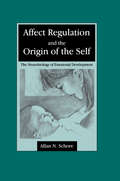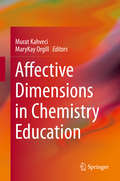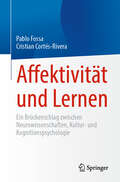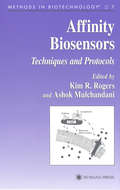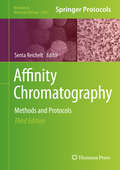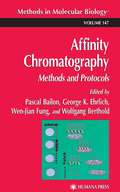- Table View
- List View
Aerosol Science
by Ian Colbeck LazaridisAerosols influence many areas of our daily life. They are at the core ofenvironmental problems such as global warming, photochemical smog andpoor air quality. They can also have diverse effects on human health, whereexposure occurs in both outdoor and indoor environments.However, aerosols can have beneficial effects too; the delivery of drugs to thelungs, the delivery of fuels for combustion and the production of nanomaterialsall rely on aerosols. Advances in particle measurement technologies havemade it possible to take advantage of rapid changes in both particle size andconcentration. Likewise, aerosols can now be produced in a controlled fashion.Reviewing many technological applications together with the current scientificstatus of aerosol modelling and measurements, this book includes:* Satellite aerosol remote sensing* The effects of aerosols on climate change* Air pollution and health* Pharmaceutical aerosols and pulmonary drug delivery* Bioaerosols and hospital infections* Particle emissions from vehicles* The safety of emerging nanomaterials* Radioactive aerosols: tracers of atmospheric processesWith the importance of this topic brought to the public's attention after theeruption of the Icelandic volcano Eyjafjallajökull, this book provides a timely,concise and accessible overview of the many facets of aerosol science.
Aerosols Handbook: Measurement, Dosimetry, and Health Effects, Second Edition
by Lev S. Ruzer Naomi H. HarleyWith the rapid growth of the nanotechnology industry, the need to understand the biological effects of aerosol exposure has become increasingly important. Featuring contributions by leading experts in the field, Aerosols Handbook: Measurement, Dosimetry, and Health Effects, Second Edition offers an up-to-date overview of many aspects of aerosols, f
Aerosols: Science and Technology
by Igor AgranovskiThis self-contained handbook and ready reference examines aerosol science and technology in depth, providing a detailed insight into this progressive field. As such, it covers fundamental concepts, experimental methods, and a wide variety of applications, ranging from aerosol filtration to biological aerosols, and from the synthesis of carbon nanotubes to aerosol reactors. Written by a host of internationally renowned experts in the field, this is an essential resource for chemists and engineers in the chemical and materials disciplines across multiple industries, as well as ideal supplementary reading in graduate level courses.
Aerospace Alloys (Topics in Mining, Metallurgy and Materials Engineering)
by Stefano Gialanella Alessio MalandruccoloThis book presents an up-to-date overview on the main classes of metallic materials currently used in aeronautical structures and propulsion engines and discusses other materials of potential interest for structural aerospace applications. The coverage encompasses light alloys such as aluminum-, magnesium-, and titanium-based alloys, including titanium aluminides; steels; superalloys; oxide dispersion strengthened alloys; refractory alloys; and related systems such as laminate composites. In each chapter, materials properties and relevant technological aspects, including processing, are presented. Individual chapters focus on coatings for gas turbine engines and hot corrosion of alloys and coatings. Readers will also find consideration of applications in aerospace-related fields. The book takes full account of the impact of energy saving and environmental issues on materials development, reflecting the major shifts that have occurred in the motivations guiding research efforts into the development of new materials systems. Aerospace Alloys will be a valuable reference for graduate students on materials science and engineering courses and will also provide useful information for engineers working in the aerospace, metallurgical, and energy production industries.
Aerospace Materials (Series in Materials Science and Engineering)
by Patrick Grant Brian Cantor Hazel AssenderAerospace Materials provides a grounding in state-of-the-art aerospace materials technology, including developments in aluminum, titanium, and nickel alloys, as well as polymers and polymer composites. Experts in each topic have contributed key overviews that summarize current knowledge and indicate future trends. The book begins by outlining the i
Aerospace Polymeric Materials
by Inamuddin Tariq Altalhi Sayed Mohammed AdnanThis book discusses polymeric and composite materials for aerospace industries and discusses some general qualities of aviation materials, e.g., strength, density, malleability, ductility, elasticity, toughness, brittleness, fusibility, conductivity, and thermal expansion. Metals and alloys have so far been best able to utilize their qualities almost to the maximum. The latest advancements in polymers and composites have opened up a new area of conjecture about how to modify airplanes and shuttles to be more polymeric and less metallic. Polymeric materials have been the focus of exploration due to their high strength-to-weight ratio, low cost, and a greater degree of freedom in strengthening the needed qualities. Strength, density, malleability, ductility, elasticity, toughness, brittleness, fusibility, conductivity, and thermal expansion are some of the general qualities of aviation materials that are taken into account. Aerospace Polymeric Materials discusses a wide range of methods with an outline of polymeric and composite materials for aerospace applications. Among the range of topics discussed are aerogel properties; polymeric welding; polymeric reinforcement, their properties, and manufacturing; conducting polymer composites; electroactive polymeric composites; and polymer nanocomposite dielectrics. In addition, a summary of self-healing materials is also presented, including their significance, manufacturing methods, properties, and applications. Audience This is a useful guide for engineers, materials scientists, researchers, and postgraduate students from industry, academia, and laboratories that are linked to polymeric composites.
Aerospace Radionavigation Systems: Electromagnetic Compatibility (Springer Aerospace Technology)
by Dmitry Alexandrovich Zatuchny Yuri Grigoryevich Shatrakov Grigory Grigoryevich Negreskul Oleg Ivanovich Sauta Artem Yuryevich ShatrakovThis book presents concepts for radio engineers to ensure electromagnetic compatibility based on the methodological approaches to reduce the probability of failures of radio equipment and improve the flight safety of complex aerospace systems. The book deals with issues related to methods for assessing the electromagnetic compatibility of integrated ground and on-board complexes, methods for obtaining information about unintentional interference, the theory of predicting unintentional interference, experimental studies of the characteristics that determine electromagnetic compatibility, methods for calculating reference systems, the influence of the method of generating the output signals of the transmitting path on the relative level of spurious radiation, electromagnetic compatibility of ultrahigh-frequency devices with phase modulation, with the features of industrial noise, with the calculation of electromagnetic fields scattered elements of the airframe, with direction finding errors caused by the scattering of electromagnetic fields by elements of the airframe, with the evaluation of isolation between antennas in the presence of an electromagnetic screen, solving problems of electromagnetic compatibility of antenna devices with the model electromagnetic interference radio systems, calculation of electromagnetic compatibility of specific navigation systems, with the provision of electromagnetic compatibility in civil aviation, taking into account modern requirements.
Aerospace Science: A Journey into Aviation History
by Linda F. SackieAerospace Science: A Journey Into Aviation History is a course about aviation history focusing on the development of flight throughout the centuries. It starts with ancient civilizations, then progresses through time to modern days. It emphasizes civilian and military contributions to aviation, the development and modernization of the United States Air Force, and a brief history of astronomy and space exploration.
Aerospace System Analysis and Optimization in Uncertainty (Springer Optimization and Its Applications #156)
by Loïc Brevault Mathieu Balesdent Jérôme MorioSpotlighting the field of Multidisciplinary Design Optimization (MDO), this book illustrates and implements state-of-the-art methodologies within the complex process of aerospace system design under uncertainties. The book provides approaches to integrating a multitude of components and constraints with the ultimate goal of reducing design cycles. Insights on a vast assortment of problems are provided, including discipline modeling, sensitivity analysis, uncertainty propagation, reliability analysis, and global multidisciplinary optimization. The extensive range of topics covered include areas of current open research. This Work is destined to become a fundamental reference for aerospace systems engineers, researchers, as well as for practitioners and engineers working in areas of optimization and uncertainty. Part I is largely comprised of fundamentals. Part II presents methodologies for single discipline problems with a review of existing uncertainty propagation, reliability analysis, and optimization techniques. Part III is dedicated to the uncertainty-based MDO and related issues. Part IV deals with three MDO related issues: the multifidelity, the multi-objective optimization and the mixed continuous/discrete optimization and Part V is devoted to test cases for aerospace vehicle design.
Aerospace Technologies and Applications for Dual Use
by Ramjee Prasad Giacinto Losquadro Hugh Griffiths Marina Ruggieri S. Greco Alexander Soucek Albena Mihovska General Pietro Finocchio Pietro Finocchio Giuseppe Morsillo Mario L. Cosmo Paul E. Gartz Gerardo Lancia G. C. Grasso Enrico Saggese S. Venturi P. Massafra K. P. Doerpelkus Carlo Alberto Penazzi Renzo Meschini Armando Buccheri Marco Tommasi Giovanni Guidotti Nunzio Cocco Marina Grossi Daniele Mortari Carlo Des Dorides Mario Ciampini S. Vetrella L. Verde U. Ciniglio F. Corraro Andrea De Martino Sergio Attilio Jesi Volker Liebig Giuseppe Veredice Ole Mørk Lauridsen L. Pasquali Massimo Capaldo Vittorio Dainelli Cosimo La Rocca Alexander Mager Tiziano Sassorossi S. Arenaccio G. Chiassarini R. Loforti F. Petrosino A. Vernucci Claudio De Bellis Michel Feuga Elisa Tonello Domenico D'Angelo Mesut CicekerThe events occurred in the last years have shown how the threat related to both intentional and natural disasters could bring the civil and the military worlds closer in the conceivement and deployment of countermeasures as well as in the identification of effective strategies for enhancing the Planet safety and security. In this frame, the concept of dual use ? the set of technologies and applications that can be exploited for both civil and military purposes - becomes a key-topic. In addition, the aerospace is a strategic building block in the deployment of a network centric environment that aims at the global protection of the mankind. Aerospace is also a natural environment for dual use: many of the related enabling technologies have been first developed for the military world and then applied to civil ? including commercial - purposes.On September 12-14, 2007 an International Symposium has been held in Roma, Italy, joining the dual use approach with the aerospace technology: the international community has been gathered around the key-topic: aerospace technologies and applications for dual use. The event has called experts and operators from the military and civil community, belonging to industry, scientific and governmental institutions. The common aim was an effective convergence between the available and perspected technologies for the civil and military worlds as well as the conceivement of applications that can take the maximum benefit from the dual approach, optimizing the available economic resources. The Symposium has included invited-only contributions and an industrial panel. The main results of the Symposium, derived from key-note speeches, invited lectures, panel discussions and conclusions have created the starting material to develop this Edited Book.
Aerospace: The Journey of Flight (Second Edition)
by Jeff MontgomeryA tremendous amount of cooperation and teamwork accompanied the production of this book, and we are extremely grateful to the many dedicated people and organizations who contributed their time, talents, and resources.
Aesthesis and Perceptronium: On the Entanglement of Sensation, Cognition, and Matter (Posthumanities #51)
by Alexander WilsonA new speculative ontology of aesthetics In Aesthesis and Perceptronium, Alexander Wilson presents a theory of materialist and posthumanist aesthetics founded on an original speculative ontology that addresses the interconnections of experience, cognition, organism, and matter. Entering the active fields of contemporary thought known as the new materialisms and realisms, Wilson argues for a rigorous redefining of the criteria that allow us to discriminate between those materials and objects where aesthesis (perception, cognition) takes place and those where it doesn&’t. Aesthesis and Perceptronium negotiates between indiscriminately pluralist views that attribute mentation to all things and eliminative views that deny the existence of mentation even in humans. By recasting aesthetic questions within the framework of &“epistemaesthetics,&” which considers cognition and aesthetics as belonging to a single category that can neither be fully disentangled nor fully reduced to either of its terms, Wilson forges a theory of nonhuman experience that avoids this untenable dilemma. Through a novel consideration of the evolutionary origins of cognition and its extension in technological developments, the investigation culminates in a rigorous reevaluation of the status of matter, information, computation, causality, and time in terms of their logical and causal engagement with the activities of human and nonhuman agents.
Aesthetic Experience in Science Education: Learning and Meaning-Making as Situated Talk and Action (Teaching and Learning in Science Series)
by Per-Olof WickmanThis book examines the role of aesthetic experience in learning science and in science education from the perspective of knowledge as action and language use. The theoretical underpinnings are based on the writings of John Dewey and Ludwig Wittgenstein. In their spirit aesthetics is examined as it appears in the lives of people and how it relates to the activities in which they are involved.Centered around an empirical analysis of how students and their teachers use aesthetic language and acts during laboratory and field work, the book demonstrates that aesthetics is something that is constantly talked about in science class and that these aesthetic experiences are intimately involved in learning science. These empirical findings are related to current debates about the relation between aesthetics and science, and about motivation, participation, learning and socio-cultural issues in science education. This book features:*an empirical demonstration of the importance and specific roles of aesthetic experiences in learning science;*a novel contribution to the current debate on how to understand motivation, participation and learning; and*a new methodology of studying learning in action.Part I sketches out the theoretical concepts of Wickman's practical epistemology analysis of the fundamental role of aesthetics in science and science education. Part II develops these concepts through an analysis of the use of aesthetic judgments when students and teachers are talking in university science classes. Part III sums up the general implications of the theoretical underpinnings and empirical findings for teaching and learning science. Here Wickman expands the findings of his study beyond the university setting to K-8 school science, and explicates what it would mean to make science education more aesthetically meaningful.Wickman's conclusions deal to a large extent with aesthetic experience as individual transformation and with people's prospects for participation in an activity such as science education. These conclusions have significance beyond science teaching and learning that should be of concern to educators generally. This book is intended for educational researchers, graduate students, and teacher educators in science education internationally, as well as those interested in aesthetics, philosophy of education, discourse analysis, socio-cultural issues, motivation, learning and meaning-making more generally.
Aesthetic Science: Representing Nature in the Royal Society of London, 1650-1720
by Alexander Wragge-MorleyThe scientists affiliated with the early Royal Society of London have long been regarded as forerunners of modern empiricism, rejecting the symbolic and moral goals of Renaissance natural history in favor of plainly representing the world as it really was. In Aesthetic Science, Alexander Wragge-Morley challenges this interpretation by arguing that key figures such as John Ray, Robert Boyle, Nehemiah Grew, Robert Hooke, and Thomas Willis saw the study of nature as an aesthetic project. To show how early modern naturalists conceived of the interplay between sensory experience and the production of knowledge, Aesthetic Science explores natural-historical and anatomical works of the Royal Society through the lens of the aesthetic. By underscoring the importance of subjective experience to the communication of knowledge about nature, Wragge-Morley offers a groundbreaking reconsideration of scientific representation in the early modern period and brings to light the hitherto overlooked role of aesthetic experience in the history of the empirical sciences.
Aesthetic and Regenerative Gynecology
by Narendra Malhotra Preeti Jindal Shashi JoshiAesthetic or cosmetic gynecology is a rapidly expanding and much in demand field worldwide. This book covers all aspects of cosmetic gynecology in great details and interdisciplinary fields. It provides information and practical tips on the new evolving and fast growing branch of aesthetic and regenerative gynecology. The book covers basics along with illustrations, practical tips and troubleshooting points. Chapters include anatomy, physiology, pathology and comprehensive management of diseases in relation to cosmetic gynecology. The book explains the basics of techniques and devices used in this field such as several energy based and high tech devices like lasers, Hifu, HIFEM, their safety profile, scope and uses in an easy to understand language supported by illustrations. It also covers complications, controversies and medicolegal issues surrounding this field. The book includes chapters from national and international experts of each technique and helps in systematic evidence based learning.The book serves as a comprehensive book for postgraduates and consultants in gynecology, plastic surgery, dermatology, urogynecology, vascular surgery, general surgery, for cosmetologists and those interested in regenerative sciences.
Aesthetics and Neuroscience: Scientific and Artistic Perspectives
by Zoï Kapoula Marine VernetThis edited monograph provides a compelling analysis of the interplay between neuroscience and aesthetics. The book broaches a wide spectrum of topics including, but not limited to, mathematics and creator algorithms, neurosciences of artistic creativity, paintings and dynamical systems as well as computational research for architecture. The international authorship is genuinely interdisciplinary and the target audience primarily comprises readers interested in transdisciplinary research between neuroscience and the broad field of aesthetics.
Aesthetics, Industry, and Science: Hermann von Helmholtz and the Berlin Physical Society
by M. Norton WiseOn January 5, 1845, the Prussian cultural minister received a request by a group of six young men to form a new Physical Society in Berlin. In fields from thermodynamics, mechanics, and electromagnetism to animal electricity, ophthalmology, and psychophysics, members of this small but growing group—which soon included Emil Du Bois-Reymond, Ernst Brücke, Werner Siemens, and Hermann von Helmholtz—established leading positions in what only thirty years later had become a new landscape of natural science. How was this possible? How could a bunch of twenty-somethings succeed in seizing the future? In Aesthetics, Industry, and Science M. Norton Wise answers these questions not simply from a technical perspective of theories and practices but with a broader cultural view of what was happening in Berlin at the time. He emphasizes in particular how rapid industrial development, military modernization, and the neoclassical aesthetics of contemporary art informed the ways in which these young men thought. Wise argues that aesthetic sensibility and material aspiration in this period were intimately linked, and he uses these two themes for a final reappraisal of Helmholtz’s early work. Anyone interested in modern German cultural history, or the history of nineteenth-century German science, will be drawn to this landmark book.
Aestivation: Molecular and Physiological Aspects (Progress in Molecular and Subcellular Biology #49)
by José Eduardo Carvalho Carlos Arturo NavasNumerous animal species live in environments characterized by a seasonal reduction in the availability of water, which often but not always occurs when temperatures are highest. For many such animals, survival during the toughest season requires spending long periods of time in a rather inactive state known as aestivation. But aestivation is much more than remaining inactive. Successful aestivation requires the selection of a proper microhabitat, variable degrees of metabolic arrest and responsiveness to external stimuli, the ability to sense the proper time of year for emergence, the preservation of inactive tissue, and much more. So, aestivation involves a complex collection of behaviors, ecological associations and physiological adjustments that vary across species in their type, magnitude and course. This book seeks to explore the phenomenon of aestivation from different perspectives and levels of organization, ranging from microhabitat selection to genetic control of physiological adjustments. It brings together authors from across the world working on different systematic groups, approaches, and questions, but who are all ultimately working to better understand the complex issue of aestivation.
Affect Regulation and the Origin of the Self: The Neurobiology of Emotional Development
by Allan N. SchoreDuring the past decade a diverse group of disciplines have simultaneously intensified their attention upon the scientific study of emotion. This proliferation of research on affective phenomena has been paralleled by an acceleration of investigations of early human structural and functional development. Developmental neuroscience is now delving into the ontogeny of brain systems that evolve to support the psychobiological underpinnings of socioemotional functioning. Studies of the infant brain demonstrate that its maturation is influenced by the environment and is experience-dependent. Developmental psychological research emphasizes that the infant's expanding socioaffective functions are critically influenced by the affect-transacting experiences it has with the primary caregiver. Concurrent developmental psychoanalytic research suggests that the mother's affect regulatory functions permanently shape the emerging self's capacity for self-organization. Studies of incipient relational processes and their effects on developing structure are thus an excellent paradigm for the deeper apprehension of the organization and dynamics of affective phenomena. This book brings together and presents the latest findings of socioemotional studies emerging from the developmental branches of various disciplines. It supplies psychological researchers and clinicians with relevant, up-to-date developmental neurobiological findings and insights, and exposes neuroscientists to recent developmental psychological and psychoanalytic studies of infants. The methodology of this theoretical research involves the integration of information that is being generated by the different fields that are studying the problem of socioaffective development--neurobiology, behavioral neurology, behavioral biology, sociobiology, social psychology, developmental psychology, developmental psychoanalysis, and infant psychiatry. A special emphasis is placed upon the application and incorporation of current developmental data from neurochemistry, neuroanatomy, neuropsychology, and neuroendocrinology into the main body of developmental theory. More than just a review of several literatures, the studies cited in this work are used as a multidisciplinary source pool of experimental data, theoretical concepts, and clinical observations that form the base and scaffolding of an overarching heuristic model of socioemotional development that is grounded in contemporary neuroscience. This psychoneurobiological model is then used to generate a number of heuristic hypotheses regarding the proximal causes of a wide array of affect-related phenomena--from the motive force that drives human attachment to the proximal causes of psychiatric disturbances and psychosomatic disorders, and indeed to the origin of the self.
Affect Regulation and the Origin of the Self: The Neurobiology of Emotional Development (Psychology Press And Routledge Classic Editions Ser.)
by Allan N. SchoreDuring the past decade a diverse group of disciplines have simultaneously intensified their attention upon the scientific study of emotion. This proliferation of research on affective phenomena has been paralleled by an acceleration of investigations of early human structural and functional development. Developmental neuroscience is now delving into the ontogeny of brain systems that evolve to support the psychobiological underpinnings of socioemotional functioning. Studies of the infant brain demonstrate that its maturation is influenced by the environment and is experience-dependent. Developmental psychological research emphasizes that the infant's expanding socioaffective functions are critically influenced by the affect-transacting experiences it has with the primary caregiver. Concurrent developmental psychoanalytic research suggests that the mother's affect regulatory functions permanently shape the emerging self's capacity for self-organization. Studies of incipient relational processes and their effects on developing structure are thus an excellent paradigm for the deeper apprehension of the organization and dynamics of affective phenomena. This book brings together and presents the latest findings of socioemotional studies emerging from the developmental branches of various disciplines. It supplies psychological researchers and clinicians with relevant, up-to-date developmental neurobiological findings and insights, and exposes neuroscientists to recent developmental psychological and psychoanalytic studies of infants. The methodology of this theoretical research involves the integration of information that is being generated by the different fields that are studying the problem of socioaffective development--neurobiology, behavioral neurology, behavioral biology, sociobiology, social psychology, developmental psychology, developmental psychoanalysis, and infant psychiatry. A special emphasis is placed upon the application and incorporation of current developmental data from neurochemistry, neuroanatomy, neuropsychology, and neuroendocrinology into the main body of developmental theory. More than just a review of several literatures, the studies cited in this work are used as a multidisciplinary source pool of experimental data, theoretical concepts, and clinical observations that form the base and scaffolding of an overarching heuristic model of socioemotional development that is grounded in contemporary neuroscience. This psychoneurobiological model is then used to generate a number of heuristic hypotheses regarding the proximal causes of a wide array of affect-related phenomena--from the motive force that drives human attachment to the proximal causes of psychiatric disturbances and psychosomatic disorders, and indeed to the origin of the self.
Affective Dimensions in Chemistry Education
by Murat Kahveci Marykay OrgillThis is a unique resource for those wishing to address the affective domain as they research and solve problems in chemistry education. Contributions by world-leading experts cover both fundamental considerations and practical case studies. This work fills a gap in the literature of chemistry education, which so far has focussed mainly on the cognitive domain. The affective domain refers to feelings-based constructs such as attitudes, values, beliefs, opinions, emotions, interests, motivation, and a degree of acceptance or rejection. It can affect students' interest in science topics and their motivation to persevere in learning science concepts.
Affektivität und Lernen: Ein Brückenschlag zwischen Neurowissenschaften, Kultur- und Kognitionspsychologie
by Pablo Fossa Cristian Cortés-RiveraDieses Buch zeigt einen interdisziplinären Ansatz zur Untersuchung der Affektivität beim menschlichen Lernen und überbrückt dabei die Kluft zwischen Neurowissenschaften, Kultur- und Kognitionspsychologie. Es vereint Studien, die über den Fokus auf kognitiv-intellektuelle Variablen, die in Lernprozesse involviert sind, hinausgehen und die Untersuchung der Rolle von Affektivität und Emotionen beim Lernen nicht nur in Bildungssettings, sondern in allen Prozessen der Transformation und der menschlichen Entwicklung einbeziehen. Dazu wird Affektivität als Katalysator und Vermittler von täglichen Lernprozessen kritisch hinterfragt und im interkulturellen Diskurs betrachtet.Die Kapitel dieses Beitragswerkes präsentieren sowohl theoretische wie auch empirische Forschung aus verschiedenen Disziplinen wie Neurowissenschaften, kognitiver Psychologie, Kulturpsychologie, pädagogischer Psychologie, Entwicklungspsychologie und Philosophie und sind in fünf thematische Abschnitte gegliedert. Der erste Teil des Buches enthält Kapitel, in denen verschiedene Aspekte der Affektivität bei Lernprozessen aus der Sicht der Kultur-, Bildungs- und Entwicklungspsychologie erörtert werden. Der zweite Teil widmet sich der Affektivität in Bezug auf Lehrkräfte während ihrer Ausbildung und während ihrer pädagogischen Praxis in verschiedenen Kontexten. Der dritte Teil befasst sich mit der Beziehung zwischen Affektivität und Lernen aus neurowissenschaftlicher Sicht. Der vierte Teil befasst sich mit Affektivität und Lernen in therapeutischen und klinischen Kontexten. Der fünfte Teil fasst Kapitel über Affektivität und Lernen im Alltag zusammen.Durch die Zusammenstellung dieser reichhaltigen interdisziplinären Sammlung von Studien wird Affektivität und Lernen: Der Brückenschlag zwischen Neurowissenschaften, Kultur- und Kognitionspsychologie eine wertvolle Quelle für Forscher in den Bereichen Psychologie, Neurowissenschaften und Bildung sowie für Erzieher und Lehrer, diemehr über die Beziehung zwischen Affektivität und menschlichem Lernen erfahren möchten.Die Übersetzung wurde mit Hilfe von künstlicher Intelligenz durchgeführt. Eine anschließende menschliche Überarbeitung erfolgte vor allem in Bezug auf den Inhalt.
Affinity Biosensors: Techniques and Protocols (Methods in Biotechnology #7)
by Kim Rogers Ashok MulchandaniA cutting-edge collection of detailed, step-by-step techniques and protocols for constructing, evaluating, and using affinity-based biosensors. Ideal for novices starting research in their field or experienced researchers wanting to use a biosensor for a specific analytical measurement, the methods detailed here allow biochemists, analytical chemists, microbiologists, and engineers to successfully apply biosensor technology to their specific problems. The techniques include the use of antibodies and membrane receptors to construct optical, thermal, acoustic, and electrochemically based biosensors. Additional techniques involve antibodies, receptors, nucleic acids, liposomes, and eukaryotic cells. A companion volume, Enzyme and Microbial Biosensors: Protocols and Techniques, by Mulchandani & Rogers, concentrates on enzyme-biosensors.
Affinity Chromatography: Methods and Protocols (Methods in Molecular Biology #1286)
by Senta ReicheltThe aim of this edition is to introduce the beginner to the basics of affinity chromatography and provide practical knowledge for the development of affinity separation protocols. Affinity Chromatography: Methods and Protocols, Third Edition guides readers through new state of the art protocols, molecular modelling, and the study of ligand-target interactions. Written in the successful Methods in Molecular Biology series format, chapters include introductions to their respective topics, lists of the necessary materials and reagents, step-by-step, readily reproducible protocols, and notes on troubleshooting and avoiding known pitfalls. Authoritative and easily accessible, Affinity Chromatography: Methods and Protocols, Third Edition is designed as a useful resource for those interested in the rapid and quantitative isolation of biomolecules with high purity.
Affinity Chromatography: Methods and Protocols (Methods in Molecular Biology #147)
by Pascal BailonDetails powerful affinity chromatography methods, ranging from traditional affinity purification such as immunoaffinity chromatography, to the use of the latest phage-display technology in the discovery of affinity ligands and drugs. Also included are separations of small molecules such as haptens, protein ligands, and supramolecular structures. Each chapter is devoted to a specific technique and includes an introduction, an explanation of principles, a detailed materials list, and instructions. Practical notes suggest alternative procedures and describe how to overcome problems.
